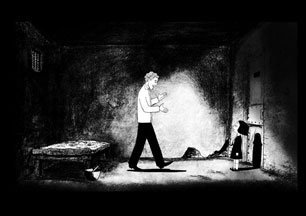At a time when movie production companies are looking to print media for inspiration, few pieces of literature have been so aptly adapted into film as “Persepolis.” Based on the graphic novel by Marjane Satrapi, “Persepolis” is an inspiring, universal tale of a woman finding her place in the world during a difficult historical time.
“Persepolis” was originally produced in French, and portrays through Satrapi’s point of view the hopes of the people of Iran during the Islamic revolution, and the disappointing reality that settled in the aftermath.
The film stays true to its roots as Satrapi and co-writer and co-director Vincent Paronnaud chose to recreate “Persepolis” in black and white animation, as opposed to live action. Scenes that refer to past events are illustrated akin to “shadow plays,” where the black shadows are illuminated from behind.
The movie begins with Satrapi as a 9-year-old shortly before the revolution. She was is an outspoken child, which did not sit well with the extremists who came to power. She wore a jacket with “Punk is not Dead” written on the back, bought a cassette tape of Iron Maiden from a trench-coated man on a street and was negligent of her hijab, the head covering that the fundamentalists forced women to wear.
Her parents, educated supporters of freedom, sent her to school in Austria, where it was difficult for her to make friends. From there, her life takes many different turns, including one where she suffers an existential crisis and sleeps on the streets of Vienna.
Throughout the movie, Marjane Satrapi is relatable as she searches for her own place in the world. The longing to find what feels right in life is something that everyone goes through, especially during the ever-dramatic teenage years.
Not only did Marjane have to find herself while away from her home, but she had to do so during a massive change in her homeland. The depiction of the Iran-Iraq war and Iran’s revolution from a monarchy to an Islamic republic is one that Americans do not often see. In that sense, the film is reminiscent of “Letters from Iwo-Jima,” as both movies are giving us a perspective that it is otherwise difficult to understand.
Given the current state of the Middle East, “Persepolis” has arrived at a pivotal time-the military situations growing worse, native people fighting for the rights that have been oppressed for too long and the gloomy prospect of the United States invading Iran come to mind while watching this film.
“Persepolis” is an important film for many to see, particularly at this point in history. It is no wonder why this film, with its title from the ancient ceremonial capital of the Persian Empire, won the Prize of the Jury at the 2007 Cannes Film Festival.
Unfortunately, the Iranian government has criticized “Persepolis,” and a government-connected organization wrote a complaint to the French embassy in Tehran saying it presented an “unrealistic face” of the events during the revolution. The Iranian government was successful in stopping the Bangkok International Film Festival from showing the film, with the festival director saying that it was “beneficial for both countries to not show the film,” and that they had to consider “other issues” that could arise from showing the movie, which the director called “good […] in artistic terms.”
Maybe, though, this is the kind of movie that needs to be shown; it provokes dialog and shows that all forms of independence, not just government-related, are sought all throughout life.





















































